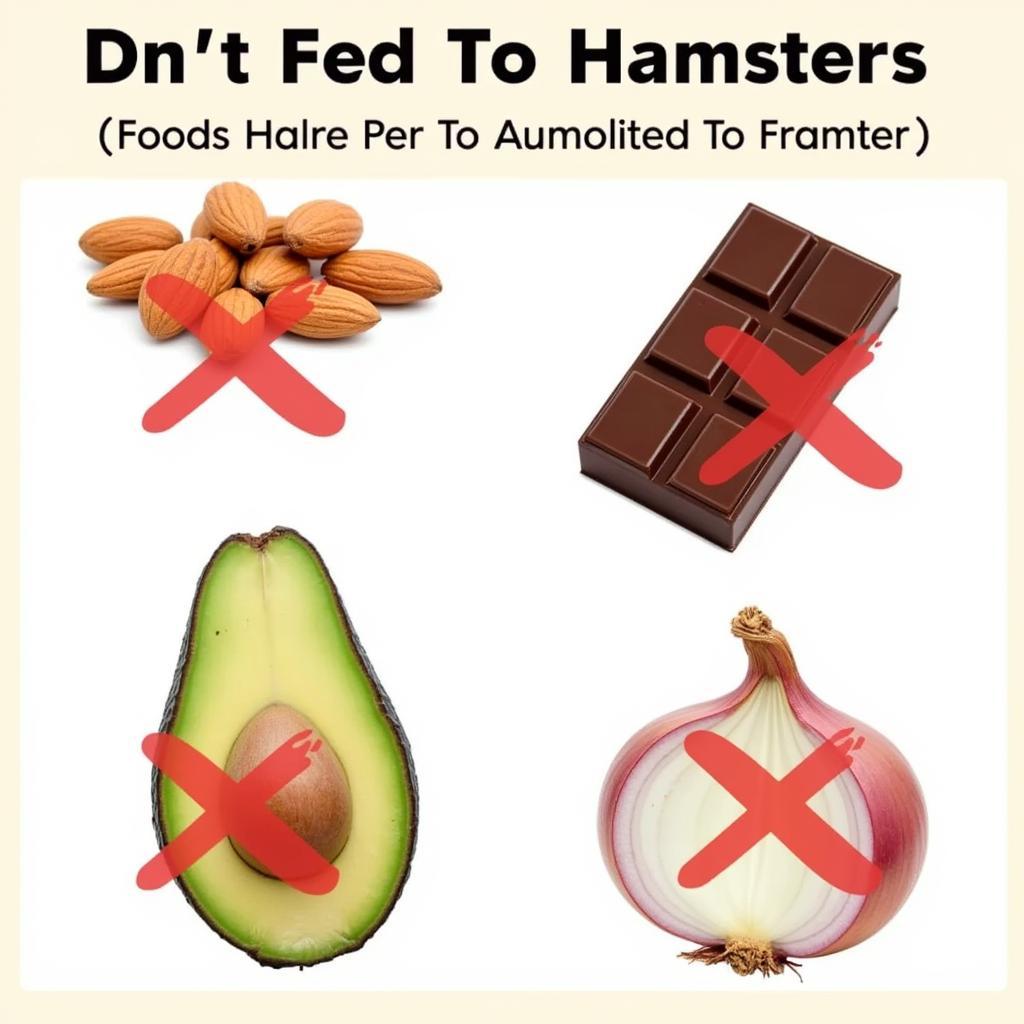Hazel Hamster Food is a crucial aspect of your pet’s overall health and well-being. Providing a balanced and nutritious diet ensures a happy, active hamster and can even contribute to a longer lifespan. This guide will delve into the intricacies of hazel hamster food, exploring what constitutes a healthy diet, debunking common myths, and offering practical tips for feeding your furry companion.
Understanding the Nutritional Needs of Hazel Hamsters
Just like humans, hazel hamsters require a varied diet to thrive. While commercial hamster food mixes form a convenient base, they shouldn’t be the sole source of nutrition. A healthy hazel hamster diet consists of a combination of high-quality hamster mix, fresh fruits and vegetables, protein sources, and occasional treats. This ensures they receive all the essential vitamins, minerals, and nutrients they need for a healthy life. A deficiency in any of these can lead to health issues, so understanding their dietary requirements is key.
The Importance of a Balanced Diet
A balanced diet for a hazel hamster isn’t just about filling their tiny bellies; it’s about providing the building blocks for a healthy body and mind. Just as a balanced diet can improve energy and mood in humans, it does the same for hamsters! A good diet helps with everything from maintaining a healthy weight to promoting strong bones and teeth and supporting a robust immune system.
Choosing the Right Hazel Hamster Food Mix
Commercial hamster mixes are widely available, but not all are created equal. Look for mixes specifically formulated for hamsters, not other rodents. Check the ingredients list and opt for mixes containing a variety of seeds, grains, and pellets. Avoid mixes with excessive sugary or artificial ingredients. High-quality mixes provide a good foundation for your hamster’s diet, but remember to supplement with fresh foods. What’s the best hazel hamster food mix? That depends on your hamster’s individual needs and preferences, but always prioritize quality ingredients.
Deciphering Hamster Food Labels
Understanding hamster food labels can be tricky. Look for a guaranteed analysis that lists minimum percentages of protein, fat, and fiber. Ideally, a hamster food mix should contain around 15-20% protein, 5-7% fat, and 5-10% fiber. Avoid mixes with high sugar content. Remember, the ingredient list is listed in descending order of weight, so the first few ingredients are the most prevalent in the mix.
Supplementing with Fresh Foods
Fresh fruits and vegetables are essential additions to a hazel hamster’s diet. Small portions of leafy greens like spinach or kale, along with vegetables such as carrots, broccoli, and cucumber, provide valuable vitamins and minerals. Fruits like apples, berries, and bananas can be offered as occasional treats. However, be mindful of portion sizes, as too much fresh food can lead to digestive upset.
Safe and Healthy Treats
While treats are a fun way to enrich your hamster’s diet, they should be given in moderation. Suitable treats include mealworms, crickets, and small pieces of cooked chicken or egg. Avoid sugary treats like chocolate or candy, as these can be harmful to your hamster’s health. What can hazel hamsters eat as a treat? Stick to healthy options like small pieces of nuts or seeds.
“Variety is the spice of life, even for hamsters! Offering a diverse range of foods keeps them happy and healthy,” says Dr. Amelia Squeakers, DVM, a renowned small animal veterinarian.
What NOT to Feed Your Hazel Hamster
Certain foods are toxic to hamsters and should be avoided entirely. These include almonds, chocolate, avocados, and onions. Always research before introducing a new food to your hamster’s diet to ensure it’s safe.
Common Hazel Hamster Food Myths
One common myth is that hamsters can eat anything. This is simply not true. Another misconception is that sunflower seeds should make up the bulk of their diet. While sunflower seeds are a good source of fat, they lack essential nutrients, and an overabundance can lead to obesity.
 Foods to Avoid Giving Your Hazel Hamster
Foods to Avoid Giving Your Hazel Hamster
“A well-balanced diet is the cornerstone of good health for your hamster. Don’t rely on myths or misinformation; consult reliable sources and prioritize their nutritional needs,” advises Dr. Emily Whiskers, PhD in Animal Nutrition.
Conclusion
Providing the right hazel hamster food is essential for their health and happiness. A balanced diet consisting of a high-quality hamster mix, fresh produce, and occasional healthy treats ensures your tiny friend receives all the necessary nutrients to thrive. By understanding their dietary needs and avoiding harmful foods, you can help your hazel hamster live a long, healthy, and fulfilling life. Remember to always prioritize their well-being and consult with a veterinarian if you have any concerns about their diet.
FAQ
- What is the best type of food for a hazel hamster? A high-quality hamster mix supplemented with fresh vegetables, fruits, and protein sources.
- Can hazel hamsters eat sunflower seeds? Yes, but in moderation. Too many can lead to obesity.
- What are some foods that are toxic to hazel hamsters? Almonds, chocolate, avocados, and onions, among others. Always research before introducing a new food.
- How often should I feed my hazel hamster? Once a day is usually sufficient, providing fresh food and replenishing their food bowl.
- How can I tell if my hazel hamster’s diet is balanced? A healthy hamster will be active, have a shiny coat, and maintain a healthy weight.
Need assistance? Contact us 24/7: Phone: 02437655121, Email: minacones@gmail.com or visit us at 3PGH+8R9, ĐT70A, thôn Trung, Bắc Từ Liêm, Hà Nội, Việt Nam.
For more information on pet care, explore our articles on hamster cages and hamster toys.